Subjects:
- General
- Type cylinder liners
- Honen
- Cylinder arrangements
- Firing Order
General:
The spaces in which the pistons move up and down are called cylinders. The inside of the cylinder is not completely smooth, because then the oil could easily move along the piston from the crankcase to the combustion chamber. Honing grooves have therefore been made. The principle of honing is described further on on this page.
The size of the cylinders determines the displacement of the engine. For each type of engine, a cylinder capacity of 1.6, 2.0 or sometimes 6.0 liters is used. This means (with a 1.6) that there is room for 1,6 liters of air in all cylinder spaces. The space is measured between the piston that is in the ODP (i.e. is at the bottom and starts with the compression or exhaust stroke) to the cylinder head. The larger the cylinder capacity, the higher/wider the cylinders are. This also depends on the bore (the diameter of the cylinder) and the stroke (the height of the cylinder).
The cylinder capacity can be calculated with the data as bore x displacement. More information about the cylinder capacity and the bore x stroke volume can be found on the page Calculate cylinder capacity.
More information about the 4-stroke process can be found on the pages Petrol engine en Diesel engine.

Type of cylinder liners:
The cylinders can be drilled directly into the engine block, cast in one piece as a complete engine block, or they can consist of loose insert bushings. Drilled or integrally cast cylinders are referred to as dry cylinder liners and the loose cylinder liners are also referred to as wet cylinder liners. Wet cans can be replaced separately and put in place by hand. They come into direct contact with the coolant and have a thicker wall than dry cans. After all, they have to be strong enough on their own. Extra gaskets are used to prevent liquid from entering the oil sump along the wet cylinder liners.
In air-cooled engines, the cylinders form a separate unit, these are provided with cooling fins and are mounted on the crankshaft housing. The surface of the ribs depends on the degree of cooling required.
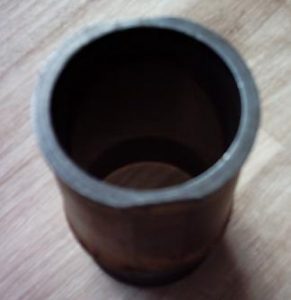
When a cylinder head is disassembled from an engine block with loose cylinder liners, it must be ensured that the liners are not shifted upwards. Problems may otherwise arise when replacing the cylinder head.
To be able to check this, a kind of large ruler or a clean straight piece of iron must be placed over the entire width of the engine block. If a cylinder liner protrudes, this will be noticed immediately. The cylinder sleeve can then be tapped downwards with light effort (carefully!).
The image on the right shows an engine with wet cylinders and the image below shows an engine with cast or drilled cylinders.
The head gasket is mounted between the engine block and the cylinder head. The head gasket provides the seal between the cylinders and between the oil and coolant channels.
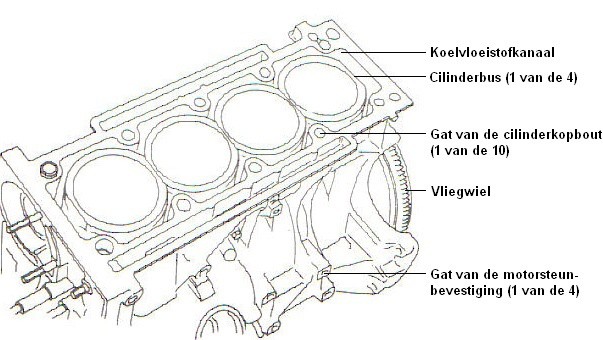
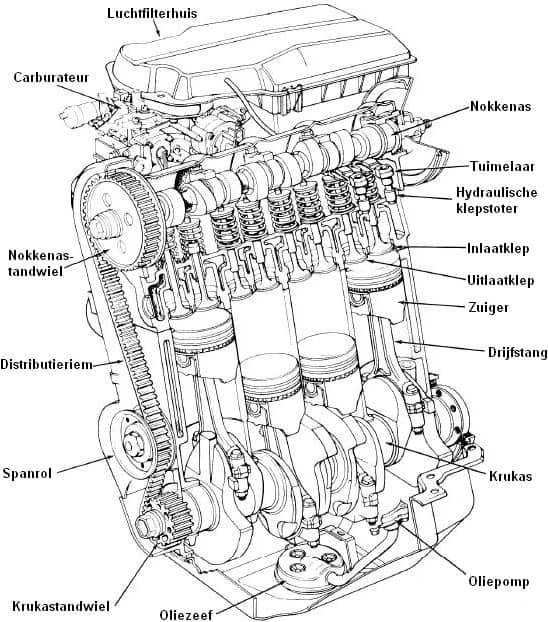
Honing:
A cylinder wall is not nicely smooth on the inside. If it were smooth and the piston would move up and down in it, there would always be a quantity of lubricating oil from the piston along the cylinder wall, at the top of the combustion chamber near the piston. And that is precisely not the intention. Also, when the engine has stood still for a while, there would be no more engine oil between the piston and the cylinder wall. The engine would then run “dry” for a while before engine oil creeps up the piston again. To prevent this, small honing grooves have been made in the cylinder wall. (Also on the side of the piston, but that will be discussed later). Honing grooves are nothing more than small scratches made at a certain angle in the cylinder wall, in which the oil partly gets stuck.
The honing grooves are usually made at an angle of 47 degrees, or sometimes 90 degrees, from each other with a special honing tool placed on a power drill. Special honing tools are shown in the images below.
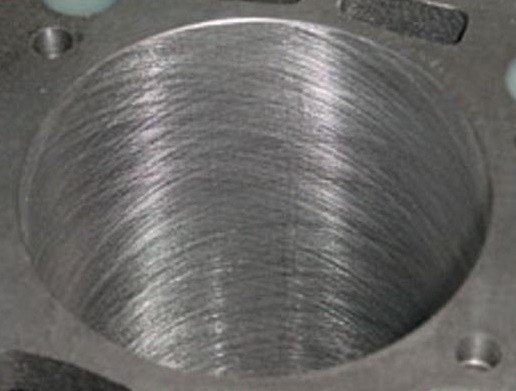
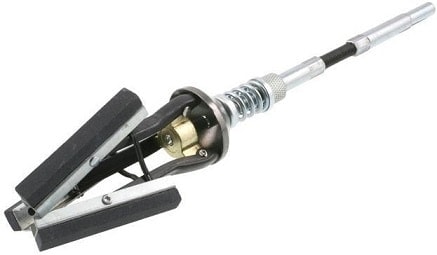
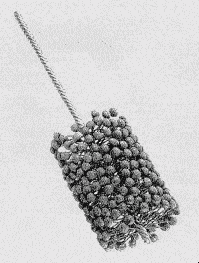
Honing the cylinder must be done very carefully. Too few honing grooves will increase oil consumption and too much will damage the protective layer in the cylinder wall.
In engine overhaul, sometimes the cylinder is also drilled and an oversized piston placed in it. The total cylinder capacity will then be larger and it will then have to be honed again. Even engines that suffer a lot from oil consumption, where the grooves have become smooth, or engines that have a light scratch in the cylinder wall, can be repaired with honing tools. If there is a deep scratch in the cylinder wall, for example from an object that has entered the combustion chamber, the scratch may be so deep that honing is no longer useful. Only drilling the cylinder wall with an oversized piston then still makes sense, or else a new engine has to be installed.
Light grooves should also be provided on the side of the piston. These too have the task of retaining a little oil for lubrication. When the pistons are smooth and the honing structure is gone, oil consumption may increase. The best measure for this is to replace the pistons and check the honing grooves in the cylinder wall.
The honing grooves can wear out (faster) when the driving conditions are not optimal, for example:
- Driving too fast with the engine cold: the piston is pressed hard against the cylinder wall by the chute force, while the engine has not yet reached temperature and the piston has not yet been properly expanded due to the temperature. More information about expanding the piston can be found on the page piston.
- Lack of lubrication, or driving for too long with old (thick) oil and therefore also a lack of lubrication.
Cylinder arrangements:
There are two, three, four, five, six, eighteen and twelve cylinders. Bugatti even has the sixteen-cylinder in the Veyron. The cylinders can be arranged vertically one behind the other. This is then called a line engine.
The cylinder can also be in the V-shape under 60 or 90. Those are V engines. If the cylinders are placed horizontally to the left and right of the crankshaft, this is a boxer engine.
The more cylinders an engine has, the more regularly it runs and the more regular the torque delivered. After all, there are more power strokes distributed over two rotational frequencies or 720 degrees of the crankshaft. The flywheel can also be made lighter with a larger number of cylinders. Balance shafts, which are necessary on the 2 and 3 cylinder engines to dampen the engine vibrations that come from the vibrations of the power strokes, are not necessary on an 8 cylinder engine.
- In-line engine: The cylinders are arranged vertically behind each other. This arrangement is most common. Modern in-line engines usually consist of 4 cylinders, but nowadays the economical, environmentally friendly 3-cylinders are also used in the VW Polo, for example, and the 2 cylinders at Fiat. BMW always places the 6 cylinders in line, never in V-shape.
- V-Motor: The cylinders are here at an angle of 60 or 90 degrees. The most common engines are the V6 and V8 engines.
There are also V5, V10 and V12 engines. The V12 engine has 6 cylinders on one side of the V-shape, and the other 6 on the other side. - VR Engine: A combination of a line engine and a V engine. This is mainly used by Volkswagen, which is known for the VR5 and VR6 engines. In a Golf R32 the cylinders are at an angle of 15 degrees to each other. This is where the advantages of the inline and V-engine are combined. With a line engine there is the advantage that the engine can be equipped with 1 cylinder head and with a V-engine the forces from the piston / connecting rod can be transferred to the crankshaft at a greater angle to each other.
- W-Motor: The cylinders are in a W-shape. This was applied in the W12 engines of the VW Touareg, the Pheaton, the Audi and the Q7.
You can actually think of this engine arrangement as two V-engines mounted on one crankshaft. The advantage of a W engine is that, given the number of cylinders, the length of the block is reduced compared to the V engine. There will be a little more space between the radiator and the paravan plate. It does mean that the spaces on the side of the engine between the crossbars have decreased.
Repair work and maintenance (such as replacing the spark plugs) does not become easier. To remove the cylinder heads it will be necessary to remove the complete engine from the car.
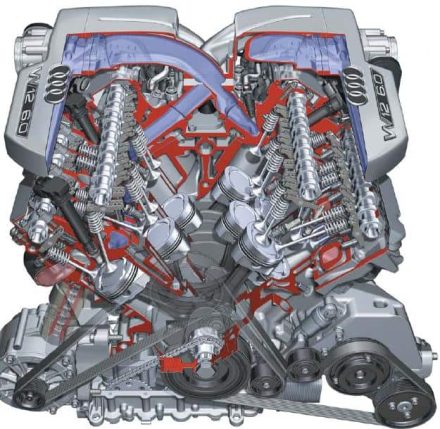
- Boxer engine: The cylinders are placed horizontally at an angle of 180 degrees.
The cylinders are placed horizontally opposite each other at an angle of 180 degrees. The advantages of this flat engine is that the center of gravity of the car is immediately lowered. The engine will also suffer less from vibrations, because the piston vibrations cancel each other out. The motor is therefore a lot better balanced and does not have to use separate balance shafts. Boxer engines are used in both passenger cars and motorcycles. Subaru is known for using the boxer engine, as well as the Citroën 2CV and the old VW Beetle.
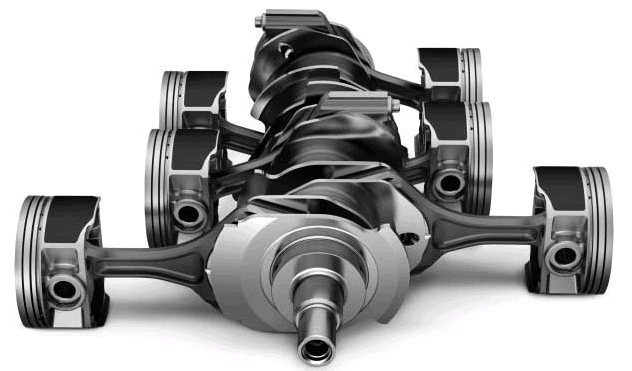
Firing order:
The ignition sequence is the sequence in which the mixture is ignited in the cylinders one after the other. The firing order depends on the design of the engine and the shape of the load distribution over the crankshaft. The table shows the usual firing orders.
| Engine type: | Amount of cilinders: | Firing order: |
| Inline engine: | 3 | 1-3-2 |
| 4 | 1-3-4-2 of 1-2-4-3 | |
| 5 | 1-2-4-5-3 | |
| 6 | 1-5-3-6-2-4 of 1-5-4-6-2-3 of 1-2-4-6-5-3 of 1-4-2-6-3-5 of 1-4-5-6-3-2 | |
| 8 | 1-6-2-5-8-3-7-4 of 1-3-6-8-4-2-7-5 of 1-4-7-3-8-5-2-6 of 1-3-2-5-8-6-7-4 | |
| V engine: | 4 | 1-3-2-4 |
| 6 | 1-2-5-6-4-3 of 1-4-5-6-2-3 | |
| 8 | 1-6-3-5-4-7-2-8 of 1-6-2-8-3-7-4-5 of 1-3-7-2-6-5-4-8 of 1-5-4-8-6-3-7-2 of 1-8-3-6-4-5-2-7 | |
| 10 | 1-6-5-10-2-7-3-8-4-9 | |
| 12 | 1-7-5-11-3-9-6-12-2-8-4-10 of 1-12-5-8-3-10-6-7-2-11-4-9 | |
| Boxer engine: | 4 | 1-4-3-2 |
| 6 | 1-6-2-4-3-5 |
